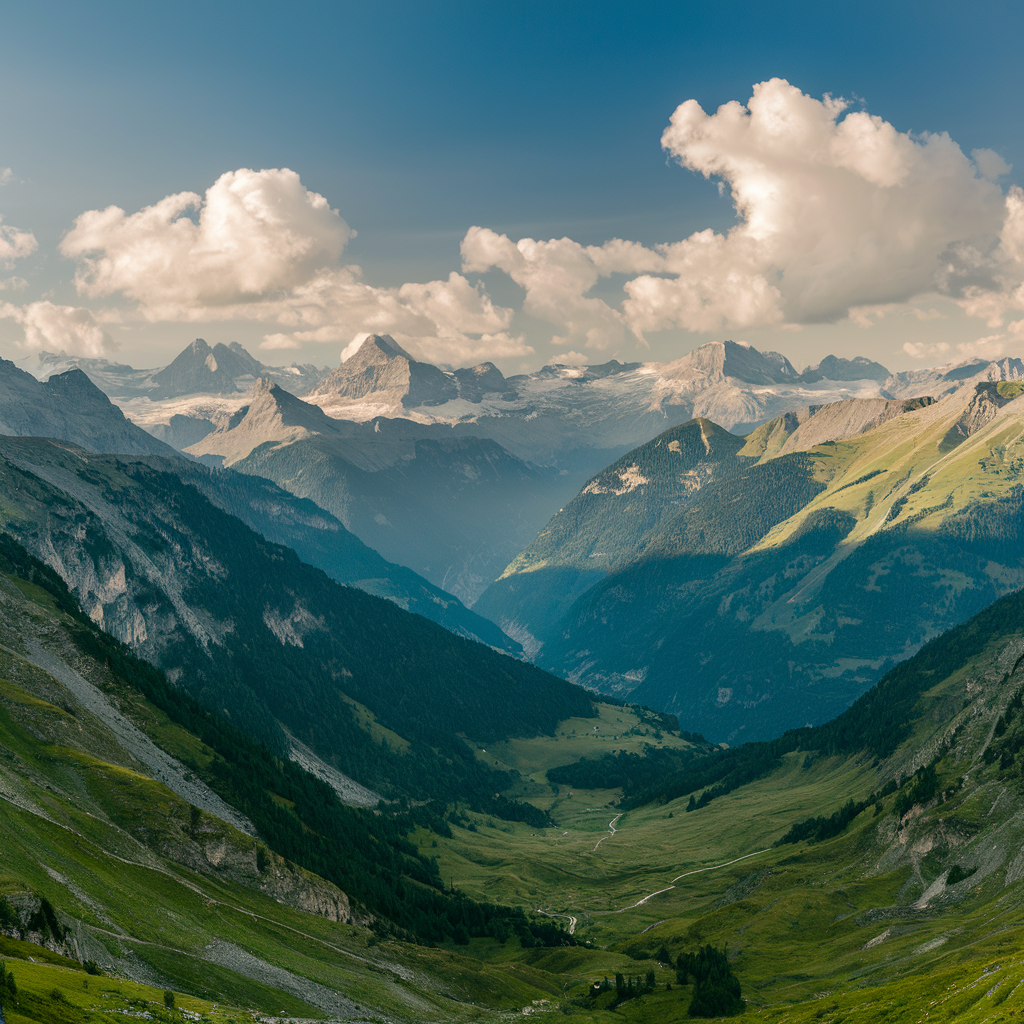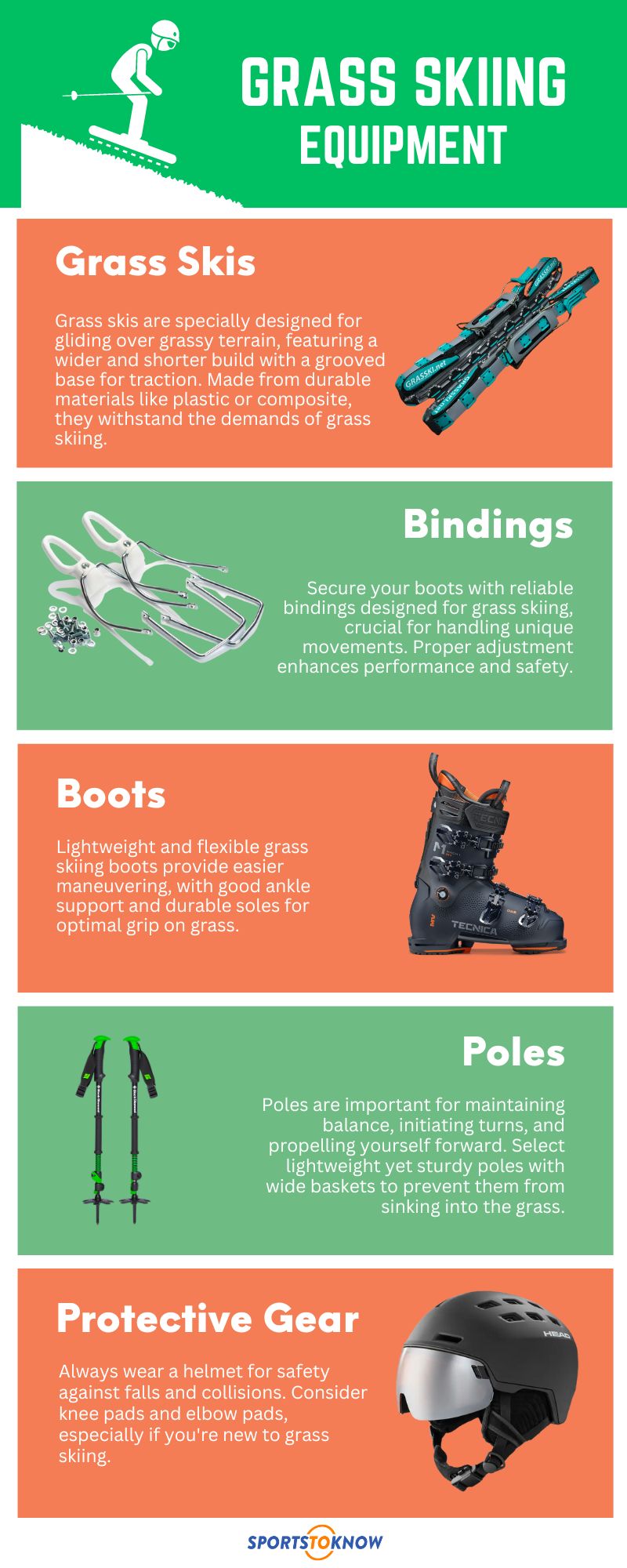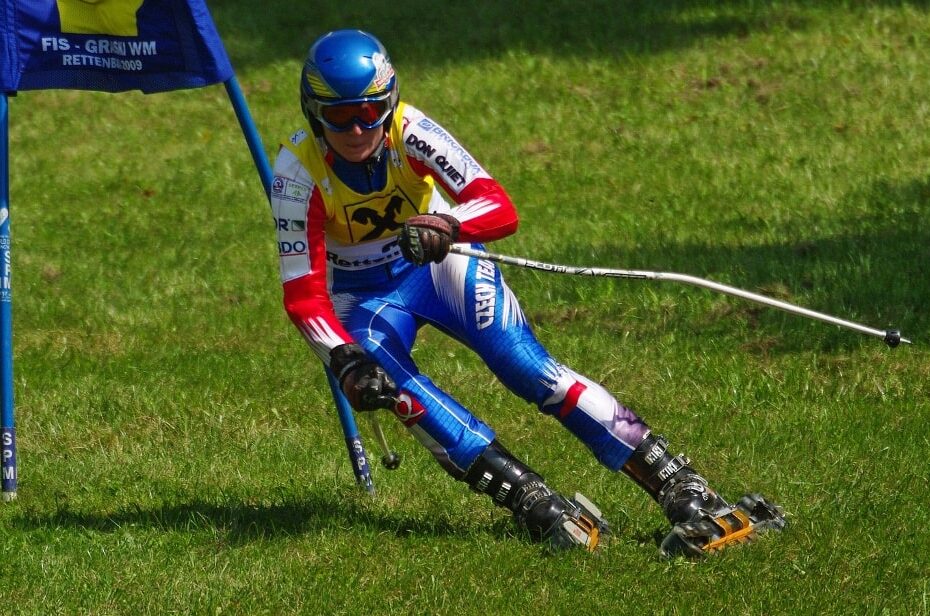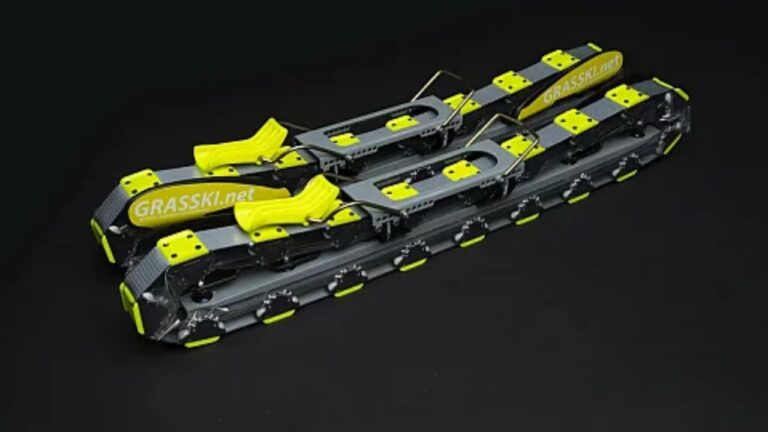You’ve heard of skiing on snowy mountains, but have you tried skiing on grass? Grass skiing brings this classic winter sport to green meadows and hills. Strap grass skis to your feet and feel the thrill of speeding down grassy slopes.
In this article, I’ll introduce you to everything you need to know about grass skiing. From the special equipment to techniques for carving turns on grass, you’ll learn how to take up this unique sport. I’ll share tips on finding the best grassy hills and maintaining your grass skis. Whether you’re an avid skier looking for a new twist or a beginner seeking an accessible way to ski, grass skiing may be the perfect sport for you.
Let’s dive into the world of skiing on grass!
What is Grass Skiing?
An Unconventional Adventure
You’ve heard of skiing on snow, but have you ever considered grass skiing? It’s an exhilarating outdoor activity that swaps out the traditional snow-covered slopes for lush, grassy hills. Imagine carving turns and catching air, all while surrounded by the vibrant hues of nature.
The Thrill of the Green
Grass skiing is a unique blend of traditional skiing and the thrill of an unusual surface. Instead of gliding over powdery snow, you’ll be navigating the undulating terrain of grassy slopes. The experience is both familiar and entirely new, challenging your skills and pushing you to adapt to the different conditions.
Gear Up for the Green
To tackle the grassy hills, you’ll need specialized equipment. Grass skis are designed with short, wide bases and edges that grip the terrain, allowing you to maintain control and stability. They’re paired with sturdy ski boots and poles, ensuring you have the necessary support and balance for this unconventional adventure.
A Versatile Pursuit
One of the best things about grass skiing is that it’s not limited by seasons or geography. While traditional skiing requires snowy mountains, grass skiing can be enjoyed in a variety of locations, from rolling hills to public parks. This versatility makes it an accessible and year-round activity for outdoor enthusiasts.
Embrace the Challenge
Grass skiing isn’t just about the thrill; it’s also a test of skill and adaptability. The unique surface demands precision and control, as you navigate the twists and turns of the grassy terrain. Whether you’re a seasoned skier or a newcomer to the sport, grass skiing offers an exciting challenge that will push you to new heights.
Grass Skiing Video
The History of Grass Skiing
Unlikely Beginnings
You might be surprised to learn that grass skiing has its quirky origins dating back to the 1960s. It all started as a bit of fun and games in the Bavarian region of Germany. Locals there would strap a pair of conventional skis to their feet and attempt gliding down grassy slopes during summer.
This odd pastime quickly gained a cult following. Soon, people all across Europe were trying their hand at “skiing on grass” whenever winter snow melted away. Of course, early grass skiers faced challenges like friction and lack of specialized gear. But their pioneering spirit paved the way for today’s thrilling sport.
The Rise of Competitive Grass Skiing
It wasn’t until the 1970s that grass skiing transitioned from a bizarre novelty to an internationally-recognized competitive sport. The first major grass ski races were organized in Germany, kick-starting a period of technical innovation.
Specialized grass skis with semi-circular grooves were designed to better glide over flat terrain. Governing bodies were established to standardize rules and equipment. Elite-level grass skiing competitions started attracting athletes and fans from around the world.
Modern Grass Skiing Worldwide
Fast forward to today – grass skiing has cemented itself as a legitimate summer sport with a dedicated global following. Top professional tours offer lucrative prize money and attract media coverage.
While Germany and other European nations remain grass skiing powerhouses, the sport’s popularity has spread. Nations like Russia, Japan and the United States now boast their own grass skiing circuits and elite competitors. Some ski resorts even construct specialized “grass ski slopes” to host offseason events.
With its rich history and growing mainstream appeal, it’s safe to say grass skiing has come a long way from those quirky Bavarian origins. It stands out as one of the most unique and thrilling “fringe” sports today – and shows no signs of slowing down anytime soon!
Grass Skiing Techniques and Styles
When it comes to grass skiing, there are a few key techniques and styles that can take your experience to the next level. Let’s dive into the different ways you can shred that grassy terrain.
Carving & Edging
Carving turns is an essential skill for grass skiers. Unlike on snow, you’ll need to really dig your edges into the grass to initiate and control your turns. Lean into the edges of your skis and use your weight to carve dynamic turns and arcs.
As you gain confidence, try linking carved turns together in a fluid, rhythmic motion. The short grass fibers offer a surprising amount of edge grip. Just don’t get too aggressive or you may catch an edge!
Buttering & Ground Tricks
One unique aspect of grass skiing is the ability to get creative with butters and ground tricks. Use the flex of your skis to press, butter, and slide along the grassy surface.
You can even attempt spinning 180s or 360s off small rollers or side-hits. Just remember that grass has more friction than snow, so spotting your landings is crucial. Start small and have fun getting technical on the grass.
Free-Riding & Big Mountain Lines
For the adventurous souls, grass skiing opens up a whole new world of big mountain freeriding lines. Without the risks of avalanches or crevasses, you can charge down steep grassy slopes and wide-open alpine faces.
Of course, be mindful of obstacles like rocks, holes, or tree stumps. But with the right technique of absorbing terrain variations through your legs, you can slay massive vert while leaving trenches in your wake.
Freestyle Jumping & Park Skills
Many grass ski areas now feature terrain parks complete with jumps, rails, and fun boxes. Transfer those park skills you learned on snow to the grass!
Go huge off jumps, rail slides, or get creative combining butters and spins. The forgiving grass offers a safer landing than hard-packed snow. Just watch out for any sketchy knolls or holes on run-ins or landings.
No matter your style, grass skiing puts a whole new spin on the sport we love. Adapt your technique, get inventive, and leave your mark on the green terrain!
The Best Places for Grass Skiing

When it comes to grass skiing, location is key. You’ll want to find areas with lush, well-maintained grassy hills that offer a smooth, consistent surface for optimal sliding. Here are some of the top spots around the world for epic grass skiing adventures.
The European Alps
While known for their powdery snow slopes, the grassy meadows of the European Alps also make for world-class grass skiing terrain. The rolling hills and mountain pastures of regions like Switzerland, Austria, and Germany provide endless options. One renowned area is the Engadin Valley in Switzerland, where skiers can cruise down pristine grassy runs with stunning alpine backdrops.
New Zealand’s Countryside
The “Land of the Long White Cloud” is a grass skier’s paradise. New Zealand’s picturesque countryside is blanketed with undulating green hills perfect for schussing. Popular locations include the Waitomo region on the North Island and the Canterbury Plains on the South Island. With breathtaking scenery and a laid-back vibe, Kiwi grass slopes deliver an unforgettable experience.
The American Heartland
Who knew America’s heartland was a grass skiing mecca? From the grassy knolls of Colorado to the rolling terrain of Wisconsin’s Driftless Area, the region offers excellent slidable turf. Utah’s Park City area has even hosted grass skiing world championships on its manicured slopes.
For an iconic American experience, cruise the grassy runs with the Rocky Mountains or Midwestern farmlands as your backdrop.
Your Local Park
You don’t have to travel far for some grass skiing thrills. Public parks, golf courses, and other open grassy areas can make awesome (if unofficial) grass skiing spots close to home. Just be respectful of the grounds and other park visitors. Some cities even have grass skiing clubs that can point you towards the best local grassy verticals. A little creativity goes a long way in the world of grass skiing!
No matter where you drop in, be sure to choose locations with good grass coverage and terrain suitable for safe, fun sliding. The thrill of grass skiing awaits in grassy meadows around the globe!
Grass Skiing Competitions and Events
If you’re looking to take your grass skiing skills to the next level, participating in competitions and events is a great way to challenge yourself and connect with the grass skiing community.
Grassroots Events
Many local ski clubs and organizations host grassroots grass skiing events throughout the year. These are perfect for beginners looking to get their feet wet (or their skis grassy). Expect a fun, low-pressure environment to mingle with fellow enthusiasts and maybe even pick up a few tips.
Regional Competitions
As you gain experience, consider entering regional grass skiing competitions. These tend to be more formal affairs, with timed runs and prizes for top finishers. But they’re still focused on fun and camaraderie. Regional events offer a taste of serious competition without the intensity of national or international contests.
Elite Grass Skiing Events
For elite-level grass skiers, there are a few marquee events each year that draw top talent from around the world. The World Grass Ski Championships and the Grasski Masters are two of the biggest. Qualifying is tough, but these prestigious tournaments showcase the highest levels of grass skiing prowess.
No matter your skill level, grass skiing competitions provide an exciting way to test your mettle against other passionate sliders. The community is welcoming, so don’t be afraid to sign up and give it your best grassy schuss!
Getting Started with Grass Skiing
If you’ve ever dreamed of skiing year-round without snow, grass skiing is your ticket. This unique sport lets you carve turns on groomed grass slopes using special skis. Here’s how to get started.
The Gear
Grass skis look similar to snow skis but have different bases and edges. The bases are made from a durable plastic material that grips the grass. The edges are beveled at a shallower angle to make turning easier.
You’ll also need grass ski boots with soles that interface with the ski bindings. Grass skiing boots are more flexible than snow ski boots for improved ankle mobility.
Take a Lesson
While the basics transfer over from snow skiing, grass skiing has some technique differences. It’s best to take an introductory lesson to learn proper form and pick up tips for turning, speed control, and stopping.
Many ski resorts offer grass skiing lessons during the summer months. Check if any local areas have a groomed grass slope and instruction available.
Find a Groomed Slope
Grass skiing requires a slope with a well-manicured, dense grass surface. Most backyard lawns won’t cut it – the grass needs to be thick and cut short. Many ski areas groom sections of their property specifically for grass skiing when there’s no snow.
Some golf courses and parks may also have suitable grassy slopes. Just be sure to get permission before dropping in.
Build Your Skills
Start on the beginner slopes and work your way up to steeper terrain as you improve. Grass skiing is generally slower than snow, but still offers an adrenaline rush as you link turns.
With regular practice, you’ll be ripping carved turns and experiencing that familiar ski sensations – all on a soft, green surface. Grass skiing is an awesome way for skiers to stay on their edges all year.
Grass Skiing Tips and Strategies
Get the Right Gear
Before hitting the slopes, make sure you have the proper equipment. Grass skis are wider and have taller edges than traditional snow skis to better grip the terrain. Poles are also longer to help with stability. Wear sturdy shoes or boots with good traction.
Start on Gentle Slopes
Begin on gentle, well-groomed slopes to get a feel for grass skiing. Leaning back slightly can help keep your edges engaged. Make wide, carved turns rather than trying to pivot skis. Expect less glide and more resistance than on snow.
Pick Your Line Carefully
Scan ahead for bumps, holes or debris that could catch an edge. Grass is less forgiving than groomed snow. Avoid sharp turns at high speeds. Gradually build up to steeper pitches as you gain experience.
Use Proper Form
Keep your weight centered and knees bent in an athletic stance. Look ahead, not down at your skis. Pole plants can aid balance and rhythm. Aggressive edging and pressure control are key to carving smooth turns.
Dress for the Conditions
Wear breathable fabrics since grass skiing can be a workout. Bring an extra layer for cooler temps. Gloves help grip poles. Sunglasses protect eyes from debris and glare. Pack water to stay hydrated.
Stay Focused
Grass skiing requires focus and an active technique. Terrain variations can come up quickly. Be ready to absorb bumps and adjust your line. Stay centered and avoid getting thrown off balance. Keeping your head up helps anticipate changes.
With the proper preparation and technique, grass skiing can be an exhilarating warm-weather way to keep your skills sharp between winter seasons. Have fun out there!
Grass Skiing Equipment – Grass Skis, Bindings, Boots, Poles

Whether you’re a seasoned skier or a complete newbie to the sport, having the right grass skiing equipment is key to a fun and safe experience. Let’s dive into the essential gear you’ll need to hit those grassy slopes.
Grass Skis
The heart of your setup, grass skis are specially designed for gliding over grassy terrain. They’re wider and shorter than traditional snow skis, with a grooved base that provides traction. Many models feature durable plastic or composite construction to withstand the demands of grass skiing.
Bindings
Just like snow skiing, you’ll need reliable bindings to secure your boots to the grass skis. Look for bindings specifically made for grass skiing, as they’re built to handle the unique forces and movements involved. Proper binding adjustment is crucial for both performance and safety.
Boots
Your boots are your connection to the skis, so choosing the right pair is essential. Grass skiing boots are typically lighter and more flexible than their snow counterparts, allowing for easier maneuvering on grass. Look for boots with good ankle support and a durable sole designed for gripping the grass.
Poles
Don’t underestimate the importance of poles in grass skiing. They help you maintain balance, initiate turns, and propel yourself forward. Opt for lightweight yet sturdy poles with wide baskets to prevent them from sinking into the grass.
Protective Gear
Safety should always come first, especially when trying a new sport. A helmet is an absolute must, as falls and collisions can happen even on grass. You may also want to consider knee pads, elbow pads, and other protective gear, particularly if you’re a beginner.
With the right grass skiing equipment, you’ll be ready to tackle those grassy slopes with confidence and style. Remember, proper gear selection and maintenance are essential for an enjoyable and safe grass skiing experience.
Grass Skiing FAQs: Answering Common Questions About Skiing on Grass
What exactly is grass skiing?
Grass skiing involves using specialized skis designed to glide over grassy surfaces. Unlike traditional snow skiing, no snow is required – just a nice grassy hill or slope. The skis have a slick base that allows you to carve turns and navigate the terrain, providing an exciting alternative for skiing year-round.
Is it hard to learn?
Not at all! Grass skiing has a relatively short learning curve, especially if you have prior experience with snow skiing or snowboarding. The techniques and body movements translate quite well. However, beginners can also pick it up quickly with some instruction and practice.
What kind of gear do I need?
The most essential piece of gear is a quality pair of grass skis, which feature bases made of a specialized plastic or sintered material to enable smooth gliding. You’ll also want grass ski poles, gloves, helmet, and clothing suited for warm weather skiing conditions.
Where can I go grass skiing?
Anywhere with good rolling hills covered in a thick, well-maintained grassy surface! Many ski resorts offer grass skiing in the summer months, while dedicated grass ski parks have also started popping up around the world. Some local parks or golf courses may even permit grass skiing when conditions allow.
Is it safe?
Like any outdoor sport, there are inherent risks involved with grass skiing that require proper safety precautions. Wearing a helmet is highly recommended to protect against falls or collisions. Going at a sensible speed and avoiding obstacles also reduces dangers. Overall, grass skiing can be safe and fun when approached responsibly.
Does it damage the grass?
Not significantly if done properly on well-maintained grassy areas. The skis’ smooth bases and edges generally don’t tear up or trench the grass. Most grass ski venues carefully groom and rotate usage areas to prevent excessive wear and tear. Following posted rules also helps minimize any potential grass damage.
With its approachability and year-round availability, grass skiing offers a super fun way to keep your skills sharp or just try an exciting new adventure sport! Hopefully, these FAQs address any initial curiosities you may have about giving it a go.
Conclusion
So there you have it, a complete introduction to the wonderful world of grass skiing. From the gear you’ll need to the techniques for carving turns, you now know everything you need to give this unique sport a try.
The best part is that grass skiing is something the whole family can enjoy right in your own backyard. No need to book an expensive mountain vacation or deal with lift lines and crowds. Just strap on those grass skis, feel the wind in your hair as you zip down the hillside, and experience an exhilarating new way to make the most of summer. This could be the beginning of a lifelong passion.
So what are you waiting for? Grab your skis and let the grassy slopes call your name. An amazing adventure awaits right outside your door.




Pingback: The Top Grass Skis for Skiing on Grass - sports to know
Wow, this post has given me useful info and answered some of my questions. I hope to give something back and aid others like you helped me. Feel free to surf my website Webemail24 about Data Mining.